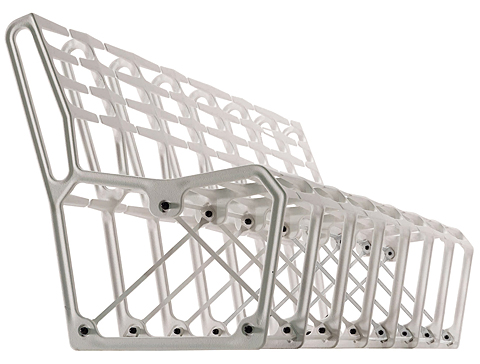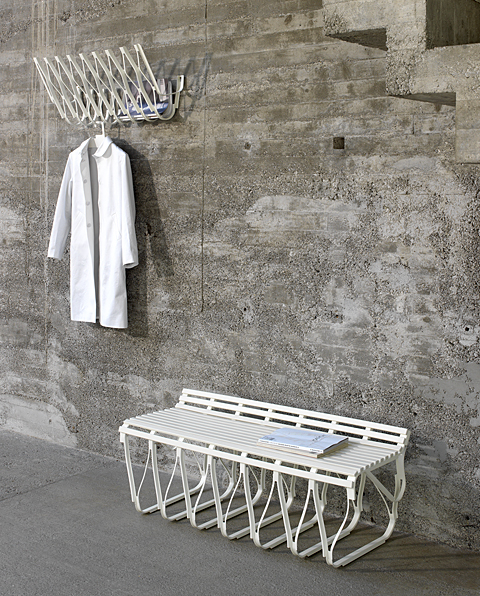Mobility and flexibility are qualities which we generally need nowadays to get through life successfully. Especially when we are young, we value not pinning ourselves down and remaining as independent as possible. We are all too happy to travel back and forth like nomads between a job in one city, a relationship in another, and friends all over the world. Thus, we are constantly in motion, be it mentally, physically or socially. Mobility is desired by many. And it extends to include with furniture. It should be modifiable and adaptable and respond in an uncomplicated way to its relevant circumstances.
The “Stitch chair” by Adam Goodrum for Cappellini, for example, holds true to its external promise of flexibility. The seat and backrest can be folded together thanks to the hinges on the sides and in the center. In contrast to many conventional folding chairs, the aluminum chair is remarkably stable. The “Stitch chair” is available in a variety of colors. Small and practical, it can always disappear behind the wardrobe, after all, city dwellers never have enough storage space.
“One_Shot.MGX” by Patrick Jouin has similar abilities to Adam Goodrum’s design. Although the name sounds like a computer file, it refers to a plastic chair which can be retracted and expanded using a central turning element. Jouin’s construction functions similarly to an umbrella, only in this case the rods twist to the side slightly, creating the shape of a diabolo, also similar to the sticks in a Mikado game, which you hold upright in your hand at the beginning and then you let them fall with a slight turning movement. With “One_Shot.MGX”, this motion forms a seat at the top. When the chair is no longer needed, you can make it disappear at once into the umbrella stand.
“Back” for B&B Italia is Patricia Urquiola’s response to the theme of flexibility. The backrest and seat of her new chair have a cover, a kind of antimacassar, which can be removed thanks to the zip on the back. In this way, “Back” can be re-dressed to suit the spatial context.
Can we imagine anything more pleasant than lying in an armchair, reading and having within reach all our favorite books, magazines, a cold drink or whatever takes our fancy? With the new, mobile shelving system “Motion” by Elisabeth Lux for Pastoe, this dream can become a reality. We no longer have to go to the bookcase; the bookcase comes to us. “Motion” consists of individual elements which are variable in height, depth and color, meaning that there is a corresponding number of possibilities of combination. The connections between the components make it possible to push the elements together or pull them apart like an accordion. Thus we can also use “Motion” as a screen to structure the space. Who wants to tie themselves down now?
Stephen Burks’ “Not so soft” collection reminds us of a built-it-yourself model kit. It consists of a round table and a bench which are composed of individual polypropylene injection-molded modules and thus are particularly suitable for outside use. 18 parts are required to build one table. As far as the bench is concerned, users can decide for themselves and even assemble just one seating segment, depending on requirements. The construction can be easily disassembled at any time and the individual parts stowed in a box until the next garden party.
The garden bench “Ghisa” by Riccardo Blumer and Matteo Borghi for Alias demonstrates at least optical flexibility. It consists of a series of modular individual elements made of cast iron, with eleven tapering ribs forming the seat and backrest of each module. The seating element is also available in a reversed format, meaning that “Ghisa” can be combined in countless different ways as desired. The snake-like structure weaves dynamically through the space and its design reminds us of a music stand or a garland, and thus also strongly of Stefan Diez’s “Upon” bench.
We live in an age of hybrid furniture, which combines old and new, reflects cultural and social conditions and in addition has as diverse functions as possible. An object for a number of occasions is the “Hanger chair” by Philippe Malouin. The chair is based on the same principle as a cut-out sheet, from which you can press out a part leaving a three-dimensional object, a chair. The clever thing about Malouin’s product is that it also has a function when it is not being used as a chair. When folded, the “Hanger chair” acts as a clothes hanger.
Another of Philippe Malouin’s designs is surprising adaptable, a design he developed in cooperation with Eurocraft. “Grace table” is an inflatable table with space for ten people. When deflated, it is so small that it can be stored in a duffle bag. Now the only thing missing are the inflatable guests.
A society gets the furniture it desires. So, now let’s quickly fold the chairs away. We want to stay flexible don’t we?!
 Back by Patricia Urquiola for B&B Italia
Back by Patricia Urquiola for B&B Italia
 Motion by Elisabeth Lux for Pastoe
Motion by Elisabeth Lux for Pastoe
 Motion by Elisabeth Lux for Pastoe
Motion by Elisabeth Lux for Pastoe
 Not so soft by Stephen Burks for Mogu
Not so soft by Stephen Burks for Mogu
 Ghisa by Riccardo Blumer and Matteo Borghi for Alias
Ghisa by Riccardo Blumer and Matteo Borghi for Alias
 Hanger chair by Philippe Malouin
Hanger chair by Philippe Malouin

 Stitch chair by Adam Goodrum for Cappellini
Stitch chair by Adam Goodrum for Cappellini
 One_Shot.MGX by Patrick Jouin
One_Shot.MGX by Patrick Jouin
 One_Shot.MGX by Patrick Jouin
One_Shot.MGX by Patrick Jouin
 Not so soft by Stephen Burks for Mogu
Not so soft by Stephen Burks for Mogu
 Ghisa by Riccardo Blumer and Matteo Borghi for Alias
Ghisa by Riccardo Blumer and Matteo Borghi for Alias
 Upon-Bank by Stefan Diez for Schönbuch
Upon-Bank by Stefan Diez for Schönbuch
 Grace Table by Philippe Malouin
Grace Table by Philippe Malouin
